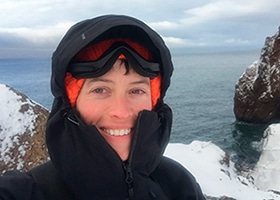Antarctica is the highest, driest, coldest and windiest continent on Earth, with no indigenous human population. Its remoteness, harsh weather conditions and lack of natural land connections have left it isokated for 35 million years. Before its discovery in 1820, no humans had seen this icy land. Do people live in Antarctica now?
Although there are no native Antarcticans and no permanent residents or citizens of Antarctica, many people do live in Antarctica each year. It’s estimated that there are up to 5,000 scientists and researchers living in Antarctica at the height of summer (October-April), along with some 45,000 Antarctic tourists visiting on expedition cruise ships. In winter, the number drops to approximately 1,000 scientific staff only.
Request a Quote
SPECIAL OFFER: Save up to 25% Off Antarctica Expeditions 22 |23
SPECIAL OFFER
Who lives in Antarctica?
There are around 66 scientific stations scattered across Antarctica, all of which serve as national research bases. These small settlements support populations of varying sizes, from as many as 1,300 to as few as six.
The majority of scientists and support staff living in Antarctica stay for short term contracts of 3-6 months, although some stay for as long as 15 months (two summers and one winter). It used to be quite common for researchers to stay in Antarctica for three summers and two winters, although that’s not common practice nowadays.
Transport to and from scientific stations is only possible during summer, as the winter brings widespread sea ice, high winds and poor visibility, making travel a highly risky prospect. Just under half of the Antarctic scientific stations close down over the cold, harsh winter, while the rest operate year-round. Brr!
In addition to scientists and researchers, some Antarctic guides spend many months living in or near Antarctica. Expedition guides, mountaineering guides and deep field guides all clock up significant time on Antarctica’s shores, islands and mountains. While they can’t necessarily call themselves Antarcticans, because Antarctica isn't a country, they no doubt feel a sense of kinship with the white continent.
How do people live in Antarctica?
Antarctic scientific stations are remote, self-sustaining outposts made up of durable buildings and transport options to support scientific research, logistical operations and the daily lives of the people who live there.
Depending on the size of the station there may be mess halls, medical facilities, educational institutions and even greenhouses! Most also have dorm-style accommodation and communal areas for entertainment and group activities.
It can be so cold that you can’t step outside without donning all your layers, right down to insulated boots, heavy waterproof jacket and thick overpants. Moving between buildings can be a challenge in rough weather, and in high-wind or white-out conditions, visibility can be so low that no one is permitted to go outside at all!
But living on a scientific base can also be fun, with inter-station dart tournaments and short film competitions, polar plunges, oversnow rides on quad bikes and occasionally, if you’re lucky, a cruise along the beautiful coastline in a Zodiac.
Antarctic scientific bases are bound by the Antarctic Treaty and the Madrid Protocol, which designates Antarctica as a natural reserve, devoted to peace and science. All activities in Antarctica are subject to environmental assessment, and station staff are responsible for ensuring that protection of the Antarctic environment is always prioritised.
So what does live in Antarctica?
Antarctica’s sub-zero temperatures aren’t only inhospitable to humans, but most other mammals as well. While penguins, seals and whales are the best known residents of Antarctica, they are seabirds and marine mammals. While they spend much of their time on the ice, they rely on the sea for sustenance, so they are not true continental inhabitants.
The land of Antarctica belongs to tiny forests of moss, lichen and liverworts, and the microscopic organisms that live within them. These include springtails, nematodes, midges and the incredibly resilient tardigrades. These hardy creatures can withstand the extremes of temperature and high winds that deter all but the most sturdy of species!
If you're interested in learning more about Antarctica or seeing for yourself what it's all about, contact our expedition experts today.

Words by Nina Gallo, Aurora Expeditions' historian and certified PTGA polar guide.
Nina has been drawn to the polar regions since her first otherworldly experience of the midnight sun in 2002. Since then she has spent time in far northern Canada, the Himalayas, the Alps and deserts in America and Australia, always seeking out quiet, wild corners to explore. She feels immensely privileged to travel to these places and shares her passions for the natural world, human stories and adventure with all the wonderful people she meets. Nina is the author of Antarctica, published by Australian Geographic in September 2020.


